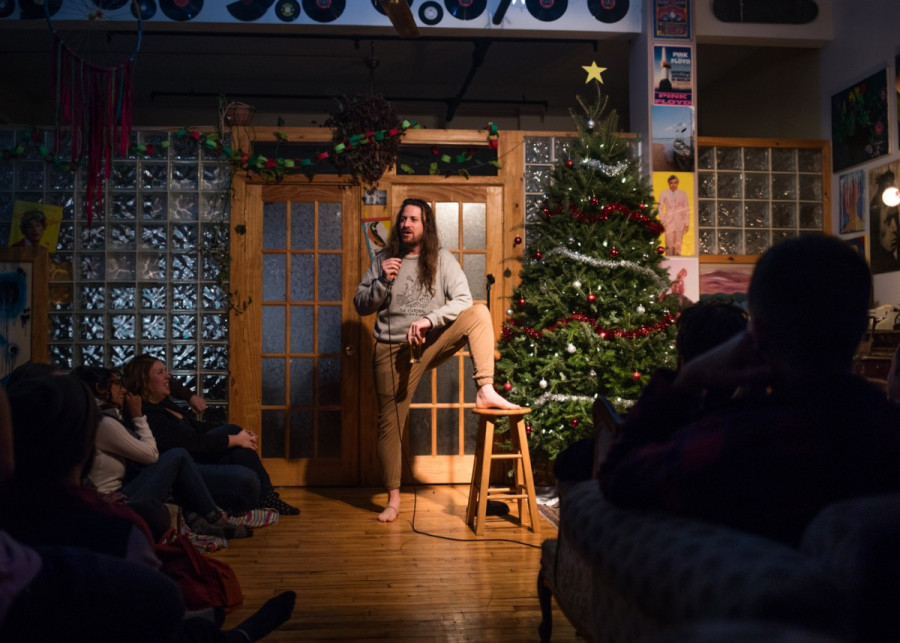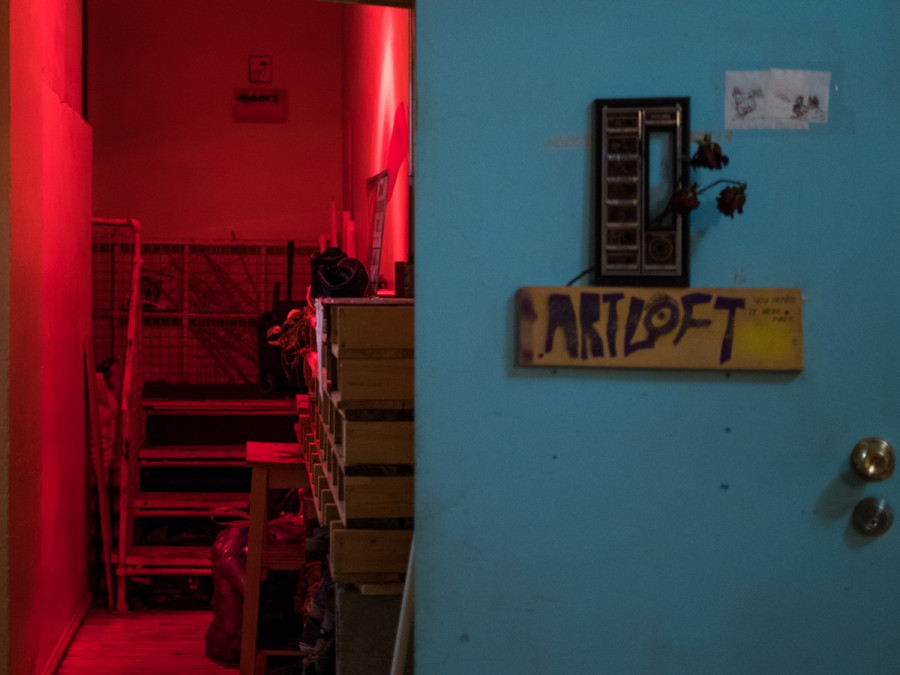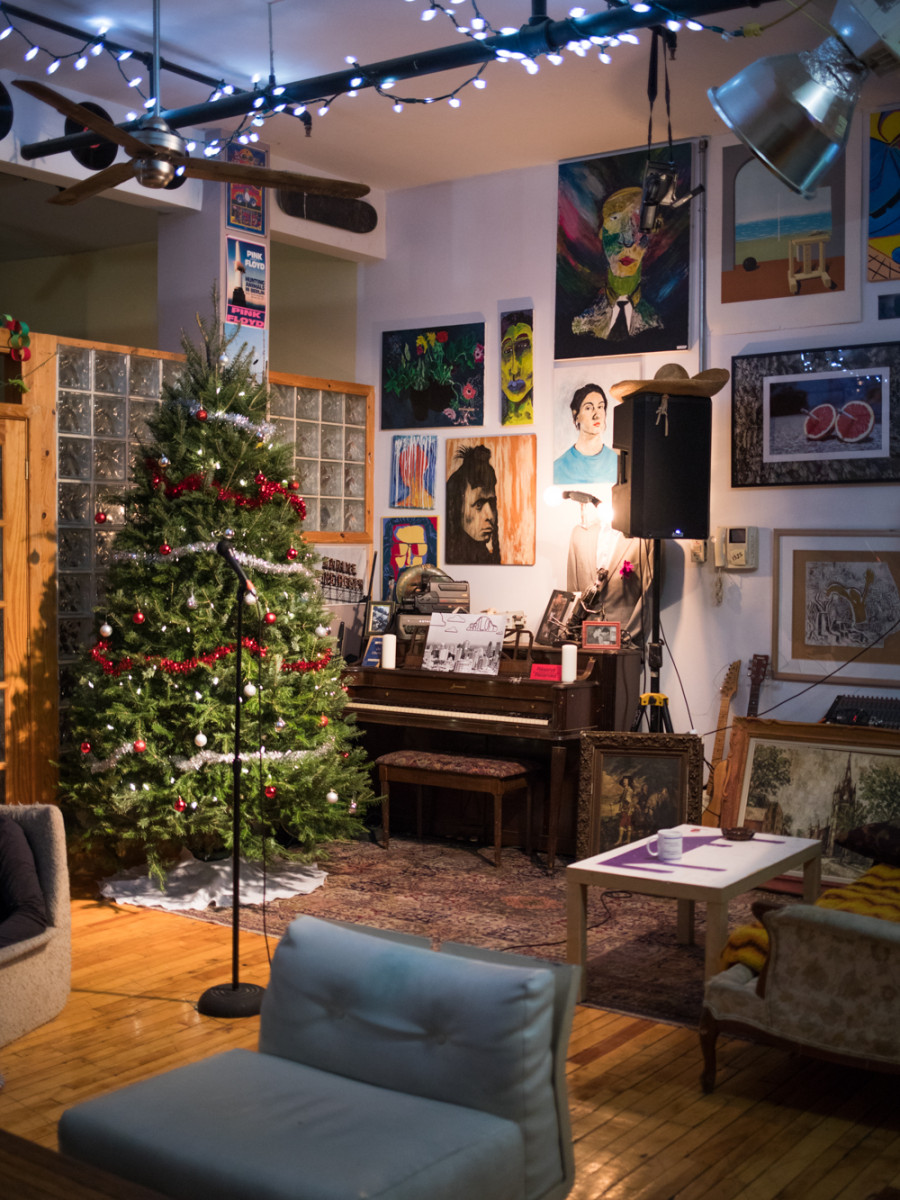Montreal’s Comedy at the Artloft Promises Real Time Laughter in a Cosy Space
Learn About One of the Most Unique Comedy Rooms in Montreal: The Artloft
If you stand across the street from 4152 St. Laurent Blvd. and look up towards the right side of the grey building you’ll see the inside of The Artloft, home to five people and a weekly bilingual comedy show.
Would you allow strangers into the place where you sleep once a week, effectively blurring the boundaries between public and private space, for the sake of art? The people who run The Artloft do just that, leading to an experience that some call the best comedy room in the city.
For around two years now the doors have opened at 9 p.m., with shows starting at around 10:30 p.m. every Friday, except during Christmas. The venue is a private home whose residents all have an important role in running the show, as well as others who’ve become integral like the “Hypeman Extraordinaire,” a comic named Vance Michel.
There’s host and booker Quinn McMorrow, DJ Cian Ponsidine, Sean Scobbie who could be considered the Artloft’s general manager, Alex Johannes Cameron the doorman, James Cadelli the videographer, and Alex Stairs the photographer.
By 10:02 p.m. on the night of “Artloft #102,” the large main room is starting to look more crowded. People trickled in at 9 p.m. when the doors first opened, installing themselves on couches, cracking open beers and chattering happily to friends. The hosts greet everyone cheerfully. The mood is ebullient; it’s a Friday night. By 10:23 p.m. the room starts to looks full, but people keep coming in. As the volume of the conversation rises, so does the music, almost imperceptibly.
At 10:40 p.m. the lights flash, before being dimmed. The only one left on is a front light shining over the microphone, where the performances will take place. The show is almost ready to start.
The atmosphere is clearly loud and celebratory like that of a bar but it differs in the sense that it feels more relaxed, as though you’re at a high school house party, but in the best way, without any of the anxiety about proving yourself.
McMorrow notes that The Artloft differs from the experience of going to a comedy club in the sense that doors for that sort of performance might open 20 or so minutes before the show, leaving people less time to catch up with their friends.
The doors opening earlier gives people the chance to talk and relax before the set begins, McMorrow explained.
The Artloft, without question, is one of the current standouts of Montreal’s art scene. Not comedy scene, but of all art available here as a whole. Is this a big statement? Yes. Is the title deserved? Yes. The space could be considered an art gallery, a living archive of Montreal’s collective artistic presence in the last two years.

The arrangement of everything inside feels like one large art installation itself; featuring smaller sculptures and exhibits within it. A giant blue fish tank sits in the middle of the room. It is supported by cinder blocks forming a rectangle, home to small stacks of books, composing an unusual bookcase. Look upwards and you’ll see twinkling white Christmas lights hanging overhead, and records alternating small and large.
“Once the ball gets rolling people are more inclined to want to leave something,” said McMorrow, noting that the artwork covering the walls changes periodically. Nothing about the visual arrangement is static, enforcing the feeling that one is in a gallery, just not a traditional one.
There is so much visual stimulation it’s hard to know where to look.
“We all like having a lot of stuff, it’s cool cause it makes people forget what they’re doing while they’re here, there’s enough distraction, […] for example during the show it’s less of a problem if someone is distracted by a painting than if they’re on their phone,” explained McMorrow.
Scobbie and McMorrow, “The original Artloft-ers,” found the space off a Craigslist advertisement around five years ago. McMorrow estimates they’ve had 20 different roommates since then. They’ve had couchsurfers and found roommates off of Craigslist, but said ones from the site have led to negative experiences that McMorrow was able to make positive use out of by using that as material for his comedy.
That is one of the most interesting aspects about The Artloft; everything happening inside of it becomes potential live material during the shows. The sets tend to be around seven minutes, finished by a longer headlining act. McMorrow warms up the audience before they start, and introduces each subsequent comedian.
The Link was present for “Artloft #102.” McMorrow announced that there was some kind of problem with the toilet at 11:05 p.m. McMorrow cracks a joke about it, “We don’t call the landlord here,” he said, giving a knowing, impish look to the audience.
Other comedians who performed that night riffed on the toilet situation too, leading to a feeling of integration with the space and the mood of evening.
While it’s worth noting that comedians at any kind of venue will pick up whats naturally going on and vamp on it, that’s an understood part of going to a comedy show, that you could be picked on, it feels very different at The Artloft because of the venue’s intimacy.
McMorrow noted that the audience has always been encouraging towards comics performing in their non-native language; the context of the space being bilingual welcomes that sort of experimentation to occur, and even encourages it.
As an example of what McMorrow was referring to occurred the night of #102, when comedian Aliya Kanani did part of her set in French, which isn’t her first language. She was very well received by the crowd, and it added to the intimacy to have someone practice and make themselves vulnerable.
“I was reading that the St. Laurent Blvd. is historically the English/French divide, […] that was kinda cool coincidentally to have it be located where there would be the divide, that there would be a show where both French and English comedians and audience come together,” — Quinn McMorrow
Artloft’s resident DJ Ponsidine was actually one of the aforementioned 20 roommates before becoming one of the Artloft’s founders.
“I immigrated here and my first day in Canada, I couch surfed here with the lads,” this was around 2 and a half years ago.“It did snowball pretty quickly. I would say by the fourth or fifth show we had 20 or 30 people in the audience. In our first show we had like maybe nine people in the audience,” said McMorrow.
The Artloft has hosted other kinds of events, like photography vernissages and a pop up markets, which were one-offs, as well as music shows that happen about once a month.
Because of the open concept of the loft, roomates sacrifice a lot of privacy to live there in general, not just when the shows occur. So what makes them capable of sustaining this kind of living arrangement? “Being passionate and slightly driven towards the space being an entity within itself [and] realizing that the space has outgrown us as individuals,” said Ponsidine.
“At a certain point too we almost have a responsibility because it does take on a life of its own,” said McMorrow.
McMorrow relayed an anecdote about how Ponsidine had to gently herd about 20 people out of the loft like sheep, using a hockey stick because they wouldn’t leave. Ponsidine added that herding sheep was something he grew up doing in rural Ireland.

The shows tend to end around 12:30 a.m. to 1 a.m. Ponsidine’s role as the DJ, always important, becomes especially so after the set ends, as he intuits the emotional temperature of the room and can influence it with his music choices. He can subliminally encourage people to leave the space by playing a soft, sad song or the opposite; playing a dance song to get an after party going.
There are not many regular bilingual comedy shows in Montreal, and to the best of McMorrow’s knowledge, The Artloft was the only one in existence at the time it was started.
Ponsidine observed that some comedians will perform their sets half and half.
“I was reading that the St. Laurent Blvd. is historically the English/French divide, […] that was kinda cool coincidentally to have it be located where there would be the divide, that there would be a show where both French and English comedians and audience come together.”
“I think that that’s one of the tickets to success as a comedy show is that it’s a unique thing,” said McMorrow, noting that the environment is uplifting and fun like a club but without certain downsides like expensive drinks or a TV blaring something you’re not interested in seeing.“It’s important to us that people have a good time […] we want you to have fun, we want you to come back,” said McMorrow.
Ponsidine observed that at The Artloft different groups of people will interact, not just sticking with the group they came with, in contrast to the atmosphere at a lot of bars.
The entrance fee is $10 or pay what you can. Most of the money goes back into the show said McMorrow. Another example Ponsidine mentioned was using the door money to buy free beer for everyone to celebrate the Artloft’s one hundredth show, which the hosts were all very excited for, even dressing up in suits.
The collaborative effort is imperative to the show’s success. “Because we all live together, we’re always discussing, maybe not the show but like The Artloft at large […] today we were sitting around talking, like maybe we could do this differently, [and] between all of us we end up getting to a conclusion,” McMorrow said. He also observed that having collaborators means that someone else always has the potential to catch something you’ve missed.
“I don’t think we’d be able to do it as well if we all had separate places […] say we just rented the loft as a space […] and just met up here Friday before the show I don’t think we’d have the same camaraderie,” said McMorrow.
Part of what makes seeing a show at The Artloft such a unique, and unmissable experience, is that it’s so personalized and intimate.
“Every time someone creates something in their image of beauty, it’s bound to be perceived as beauty by others,” said McMorrow.


_600_832_s.png)


